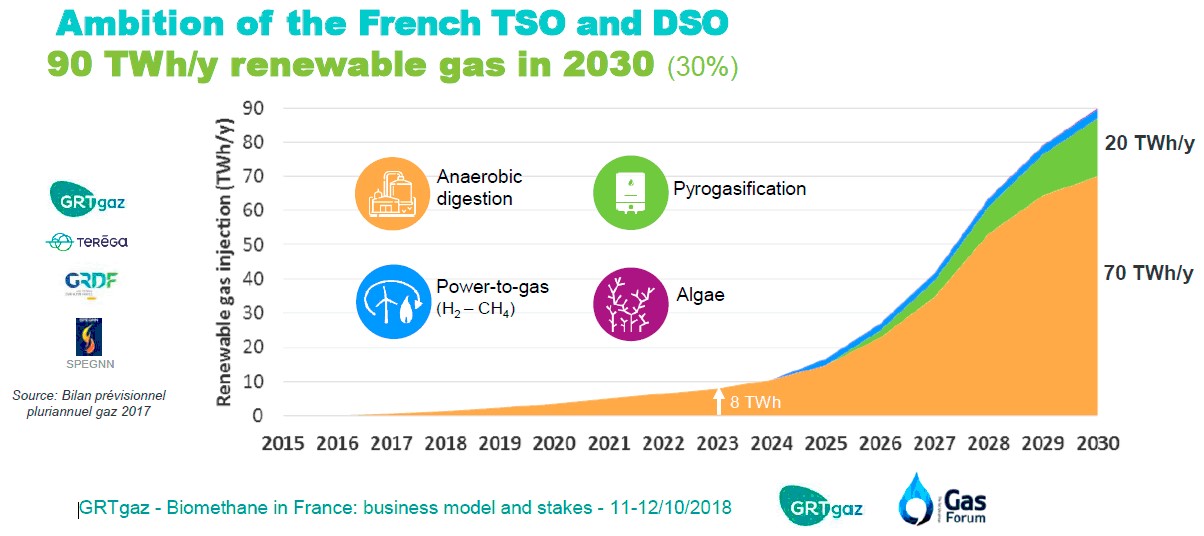The European Biogas Association (EBA), according to the project GreenGasGrids, predicts accelerated growth of biomethane production, in the overall production of biogas, in Europe by 2030 (Fig. 1). According to the forecast, in 2020 26% of biogas will be enriched to the quality of natural gas (this is 6.5 billion m³ of biomethane).
In 2030, the share of enriched biogas in accordance with the EBA forecast should increase to 37.5% (this is 18 billion m³ of biomethane). To fulfill plans for 2020, the biomethane market should grow at a rate of 50% per annum relatively the indicator for the end of 2017 (1.94 billion m³). The transition from 2020 to 2030 will require an increase of 10.7% per annum.
Fig. 1 – Forecast of the development of the biogas market in Europe until 2030 (EBA)
The development plan, which was prepared by the European Network of Transmission System Operators for Gas (Ten-Year Network Development Plan 2017) presents various scenarios for the development and production of biomethane in gas networks (Fig. 2). Three main bio scenarios are considered: slow progression, blue transition and green revolution/evolution. By implementing the latest, most optimistic scenario, the production of biomethane in Europe in 2030 can reach 17 billion cubic meters, which is in line with the above-mentioned EBA forecasts, and in 2037 the production of biomethane could reach 25 billion cubic meters. One of the conditions for the implementation of this scenario is the rapid growth of the CO2 tax.
The upper part of the Figure shows the actual production of natural gas in Europe, which will begin to decline after 2022. Such trends may lead to the fact that in 2037, half of its own European gas will be provided at the expense of the production of biomethane.

Fig. 2 – The potential of biomethane supply in gas networks for Europe for the three scenarios of market development compared to its own natural gas production. (Source: TYNDP 2017 – ENTSOG)
Particularly interesting in this context is information for individual countries. On Fig. 3 shows the breakdown of production of biomethane (BM) by countries according to the data of national operators of gas networks. According to these data, Italy within a few years will be the European leader in the production of biomethane. Significant contributions will be made by the Netherlands, France, and the United Kingdom. The total share of all other countries, including the modern leader – Germany – will not exceed 10%. It is assumed that if legislative support for biomethane in Germany does not change, even incomparable in size Denmark will exceed Germany’s biomethane production indicators.
Fig. 3 – Projection of biomethane production in EU countries
(Джерело: TYNDP 20p17 – ENTSOG)
Italy
The rapid growth of biomethane in Italy will be achieved by a combination of several factors (more details in our subsequent publications). The country is primarily encouraged to use biomethane in transport. Already today in Italy there is a developed infrastructure for the use of gas as motor fuel. More than a million cars and 3300 buses use methane as fuel. There are 250 stations on compressed methane (CNG) and 22 liquefied methane stations (LNG) in Italy. The national energy strategy of the country envisages the construction of 2,400 CNG and 800 LNG stations by 2030.
France
France supports the production and supply of biomethane in gas networks, regardless of its further use. It is anticipated that in 2023 the production of biomethane in the country will be 8 TWh (800 million cubic meters), and in 2030 – about 90 TWh (9 billion cubic meters) or one-third of natural gas consumption (Fig. 4). 7 billion cubic meters of gas will be provided through fermentation processes, 2 billion cubic meters by means of thermal gasification and subsequent methane synthesis gas, and about 200 million cubic meters of biomethane from the process of obtaining hydrogen by electrolysis.
Fig. 4 – Projection of biomethane production in France
Denmark
Denmark considers biomethane as a natural substitute for natural gas. Already in 2025, the production of biomethane and natural gas in the country will equalize (Fig. 5), and in 2035, biomethane in Denmark will completely replace natural gas.

Fig. 5 – Projection of biomethane production and consumption of natural gas/biomethane in Denmark
Denmark is developing the concept of sustainable energy networks, which combines electricity and gas networks, as well as a centralized heat supply system.
Biomethane is a renewable and time-consuming energy source with the possibility of accumulation in gas networks. These features allow to consider it as an important component of the energy system and as the solar and wind energy balancer.